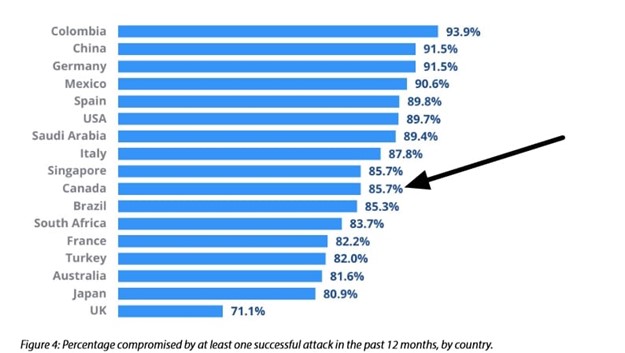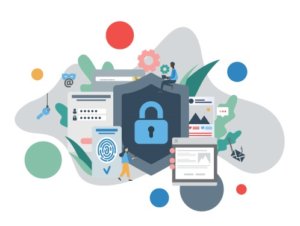On September 15, the Hive ransomware group claimed to have launched an attack against Bell Technology Solutions on August 20, 2022. The compromised information contained approximately 1.9 million active email addresses, 1,700 names, and active phone numbers.
Bell Technology Solutions is a subsidiary of Bell Canada, a leading communications company and communications provider for over 140 years. They offer comprehensive services, including wireless, high-speed Internet, TV, home phone, and business communications.
This attack highlights the importance of data security and proper cyber hygiene. Ransomware groups are becoming increasingly sophisticated and can often exploit systems vulnerabilities to access and encrypt data.
Organizations must ensure that their systems are up to date and secure to protect themselves from these attacks.
What Happened in the Bell Canada Cyber Attack?
This cyber incident has posed a threat to not only Bell Canada’s cyber security infrastructure but also their overall brand reputation.
The Hive ransomware gang claimed responsibility for the attack and indicated on its site that it encrypted data from August 20 before publishing the stolen data almost a month later. It is not yet clear how the group gained access to Bell Canada’s systems or exactly how much data they were able to obtain.
Some of the compromised documents contain bank data. At least one file even includes an employee’s full credit card number. An unknown number of customers who booked technician visits also had their names, addresses, and phone numbers leaked during the incident.
In a statement, Bell Canada ensures users that they “will directly notify any individuals whose private information may have been accessed. Bell Technical Solutions operates independently from Bell on a separate IT system; other Bell customers or other Bell subsidiaries were not impacted.”
Bell is working with law enforcement to investigate this matter and develop solutions to protect customers’ data and prioritize the retrieval of sensitive information unauthorized parties have accessed.
Impact of Bell Canada's Cyber Attack
This cyber attack serves as a reminder that all organizations, big and small, can be on the receiving end of a similar incident if they don't take proper precautions. Data breaches can result to:
- Temporary or permanent loss of sensitive information
- Stalled productivity which leads to the next point
- Financial losses for the organization
- Damages to a brand’s global reputation
- Vulnerability to future attacks due to uncertain threat removal
Growing Cyber Attack Incidents in Quebec
In recent years, the number of cyber attacks in Quebec has been growing at an alarming rate. In fact, according to a recent report by the Canadian Cybersecurity Strategy, the province has seen a 300% increase in cyber incidents in the past three years alone. Several factors have contributed to this trend, including:
- The growing sophistication of cyber criminals and their attacks
- The ever-growing amount of sensitive data stored online.
- A growing population of internet users in Quebec
According to the same report, most cyber incidents in Quebec are targeting small and medium-sized businesses. This trend is largely tied to the fact that these organizations are often less prepared to deal with such attacks and have fewer resolution resources at their disposal.
As a result, they can be easy targets for cyber criminals.

How to Protect Your Organization from Ransomware Attacks and Other Cyber Threats
One of the most prevalent cyber threats that can afflict organizations of all sizes, regardless of their region of operation or industry, is ransomware. Ransomware is malware that encrypts your files and demands a ransom to decrypt them. It can be costly and devastating if you're hit with it, as you may lose access to important files forever. Fortunately, you can take steps to improve your efforts in preventing ransomware.
- Always keep backups of your important files. That way, even if you get hit with ransomware, you'll have a copy of your data.
- Make sure your computer has up-to-date security software installed. This layer of protection will help to stop various cyber threats from infiltrating and infecting your system in the first place
- VPN usage is highly recommended when accessing sensitive information via an unsecured network or when you're working remotely
- Be careful about the emails you open and the links you click. Ransomware is often spread via phishing emails, so be cautious about any that come your way.
- If you're not sure if an email is legitimate, never click on any links or attachments it contains
- Finally, stay up to date on the latest security threats. Keep an eye out for news about new ransomware strains and update your security software accordingly
By following these steps, you can help protect yourself from cyber attacks. However, information security can never be guaranteed despite the best efforts of technological safeguards. This statement is especially true in the case of threats like ransomware, which are becoming increasingly common and sophisticated.
While this incident is a reminder of the increasing cases of cybercrime in Canada and beyond, it should also serve as a wake-up call for companies to adopt better efforts to protect their customers' data.
Don't be a victim of cyber attacks. Establish security awareness training among your users starting today.

Cyber Security Hub: Access Exclusive Cyber Security Content
Learn more and share crucial information about phishing, social engineering, and other cyber threats by visiting the Cyber Security Hub.